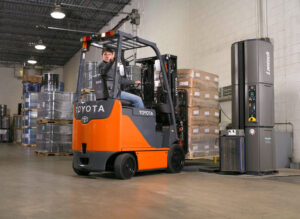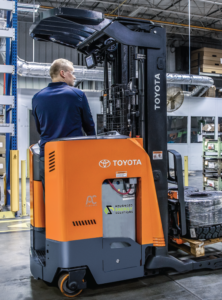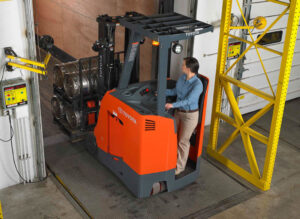Archive for September, 2023
What You Need To Know About Automated Guided Vehicles
Automated Guided Vehicles (AGVs) are reshaping the way industries operate, offering a bounty of benefits for those ready to embrace the future of automation. Learn how autonomous machines increase efficiency across various sectors and how you can introduce them into your operations with little or no infrastructure required.
Understanding AGVs
AGVs are self-operating mobile robots guided by sensors, cameras, and predefined routes or markers. They transport goods, materials, or products within a facility without human intervention. AGVs can come in various forms, from small, compact robots to larger, more specialized machines, depending on the application’s specific needs.
Six Ways AGVs Boost Efficiency
- Improved Workflow and Material Handling: AGVs excel in repetitive and time-consuming tasks like material transport. By deploying AGVs in a facility, companies can significantly reduce the time and effort spent moving goods from one location to another.
- Precise and Consistent Operations: AGVs operate with remarkable precision. They can follow predefined routes within millimeter accuracy, ensuring that materials are delivered to the correct location every time. This level of consistency minimizes errors and reduces the need for rework, ultimately improving overall efficiency.
- 24/7 Operations: Unlike human workers who need breaks and rest, AGVs can operate around the clock. This continuous operation capability means production can continue uninterrupted, increasing output and efficiency.
- Scalability: As businesses grow, their material handling needs often increase. AGV systems are easily scalable by adding more robots to the fleet. This flexibility ensures companies can adapt to changing demands without significant disruptions or delays.
- Safety and Reduced Downtime: Safety is a top priority in any industrial setting. AGVs use advanced safety features such as collision avoidance systems and emergency stop capabilities to help protect employees and minimize downtime due to accidents.
- Data-Driven Optimization: AGVs use sensors and cameras that collect valuable data about operations, including traffic patterns, cycle times, and resource utilization. This data helps identify areas for optimization and continuous improvement.
Applications Across Industries
AGVs are versatile and find applications across various industries:
- Manufacturing: AGVs transport materials to assembly lines, reducing idle time and increasing production rates.
- Warehousing and Distribution: AGVs efficiently move goods within warehouses, helping to meet the demands of e-commerce and same-day delivery services.
- Healthcare: AGVs are used in hospitals to transport medications, supplies, and linens, allowing healthcare professionals to focus on patient care.
- Automotive: AGVs help automotive plants deliver parts, support assembly lines, and transport finished vehicles.
- Agriculture: AGVs can automate crop harvesting and transportation in large-scale farming operations.
Toyota’s Automated Forklifts
Toyota’s Automated Forklifts rely on LiDAR-based natural features navigation, ensuring precise positioning and load delivery with accuracy tolerances of as little as half an inch.
What is the benefit for you? You won’t have to undergo the hassle of reorganizing your facility’s infrastructure or dealing with a complex setup process. We create a detailed map of the designated work area for the Toyota Center-Controlled Rider Automated Forklift, and the equipment takes care of the rest effortlessly.
Toyota currently offers two Automated Forklifts.
- Center-Controlled Rider Pallet Jack: Constructed upon the dependable foundation of the Toyota Center-Controlled Rider Pallet Jack, the groundbreaking Toyota Center-Controlled Rider Automated Forklift leverages state-of-the-art environmental sensing to automate repetitive warehouse tasks. Employing advanced sensors for cutting-edge mapped-object detection combines Toyota’s renowned warehouse equipment reliability with cutting-edge automation technology. This synergy results in cost reduction and operational streamlining for your facility.
- Core Tow Tractor Automated Forklift: The Toyota Automated Core Tow Tractor uses an advanced AC Drive System, AC Drive Motor, and regenerative braking capabilities. This powerful tow tractor significantly enhances productivity and is the perfect solution for horizontal material transport and cart pulling within your facility. Furthermore, each AGV in the lineup harnesses the power of LIDAR-based natural features navigation, reducing the need for extensive infrastructure or intricate setup procedures.
Learn more about Toyota’s Automated Forklifts and see them in action here: https://www.youtube.com/watch?v=kqhoxPySs4M.
AGVs represent a paradigm shift in industrial automation, offering many advantages to businesses seeking to enhance efficiency. If you are ready to embrace the AGV revolution and unlock the full potential in your operations, contact our automation experts to schedule a free consultation today.
How To Determine What Forklift You Need
When efficiency is the key to success, choosing the right equipment is essential. Forklifts, reach trucks, and stand-up riders are commonly used in warehouses and distribution centers. While they may seem similar initially, they serve distinct purposes and excel in specific applications. In this blog post, we’ll explore the differences between forklifts, reach trucks, and stand-up riders and help determine your needs.
Forklifts 
Forklifts are workhorses of the warehouse and industrial world. They are versatile and can be used in various applications, making them a staple in many workplaces. Here are four key features and applications of forklifts:
- Lifting Capacity: Forklifts are known for their impressive lifting capacities, capable of handling heavy loads ranging from 3,000 to 36,000 pounds or more, depending on the type and model.
- Lifting Height: Forklifts typically lift loads to lower heights, making them ideal for applications where items are moved on and off pallets or loaded onto trucks.
- Maneuverability: Forklifts are designed for maneuverability in tight spaces, making them suitable for indoor use in warehouses, manufacturing facilities, and distribution centers.
- Fork Length: Forklifts feature longer forks, which allow them to easily slide under pallets or other heavy objects for efficient lifting and transport.
Reach Trucks 
Reach trucks are for more specialized applications, particularly for lifting and transporting palletized loads in narrow aisles or racking systems. Here are four key features and applications of reach trucks:
- Lifting Capacity: While reach trucks are not as powerful as forklifts, they still offer substantial lifting capabilities, often ranging from 2,500 to 5,000 pounds.
- Lifting Height: The standout feature of reach trucks is their exceptional vertical reach. They can lift loads to heights of 30 feet or more, making them perfect for high-density storage in narrow aisles.
- Maneuverability: Reach trucks are for precise handling in confined spaces. Their ability to navigate narrow aisles and tight corners makes them the preferred choice for efficiently using vertical storage space.
- Fork Length: Reach trucks have shorter forks than forklifts, explicitly designed for accessing pallets in narrow racking systems.
Stand-Up Riders 
Stand-up riders, also known as stand-on forklifts, are versatile for various material handling tasks. Here are their key features and applications:
- Lifting Capacity: Stand-up riders typically offer a lifting capacity similar to traditional forklifts, making them suitable for handling medium to heavy loads.
- Lifting Height: While they may not reach the same heights as reach trucks, stand-up riders can lift loads to significant heights, often exceeding 20 feet.
- Maneuverability: Stand-up riders balance maneuverability and capacity, making them versatile for indoor and outdoor use. They are convenient in busy warehouses and distribution centers.
- Operator Position: The operator stands on the platform of a stand-up rider, offering a better view of the surroundings and improved ergonomics during extended use.
When to Choose One Over the Other
Now that we’ve explored the characteristics of forklifts and reach trucks, let’s discuss when you might need one over the other:
Choose a forklift when:
- You need to handle heavy loads that exceed 5,000 pounds.
- Your primary task involves loading and unloading goods at ground level or within a warehouse.
- Maneuverability in narrow aisles is not a significant concern for your operations.
Choose a reach truck when:
- You require high-density storage in narrow aisles or racking systems.
- Your lifting needs focus on accessing goods at significant heights.
- Precise maneuverability in confined spaces is crucial to your operations.
Choose a stand-up rider when:
- You require versatility in both indoor and outdoor environments.
- Handling medium to heavy loads is part of your daily tasks.
- Operators need an elevated view for better visibility and ergonomics.
Understanding the differences between these three products will help you make an informed decision for your material handling operations, ultimately improving productivity in your workplace.
Are you still trying to decide which one is right for your application? Our industry experts can help you make the right decision. We also recently teamed up with Advanced Energy Solutions to help with various services, including forklift power options, battery maintenance systems, preventative maintenance services, and more. h more. Contact us to speak with an expert today.
